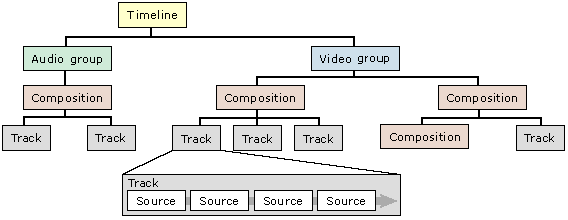
| Microsoft DirectX 8.1 (C++) |
A video production starts out as a collection of raw source files, such as video clips, sound files, and still images. The producer or video editor takes sections of those files—ten seconds from one clip, five seconds from another, thirty seconds from another. Then he or she arranges them in a particular sequence.
In the simplest case, the clips appear in a strictly linear order: Each clip is followed by the next. This basic arrangement forms a track. Thus, a simple production might contain just one video track and one audio track. More sophisticated productions use multiple tracks. For example, several audio tracks can be mixed together. The tracks might include audio effects, so that a track fades out while another fades in. With video, one track can transition to the next, using a fade or wipe. This is an example of compositing. Another example is a chroma key, in which the background of one track is keyed out and replaced by a different track. (An example of chroma keying is a weather forecaster placed in front of a satelite image.)
Thus, a video production contains source clips that are arranged in time (one clip followed by another) and in layers (one clip composited onto another). DES represents this organization using a tree:
A timeline must contain at least one group. Each group represents a single stream in the final production. A typical production includes one video group and one audio group. Compositions are optional; they exist to provide more structure if needed.
The following illustration shows the timeline structure. This illustration shows child-parent relations in the tree, but not the time sequence.
